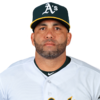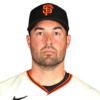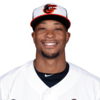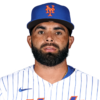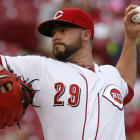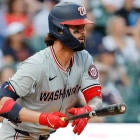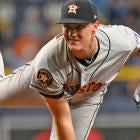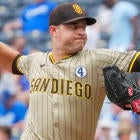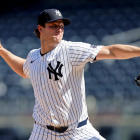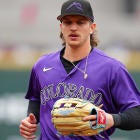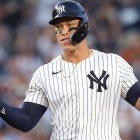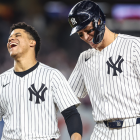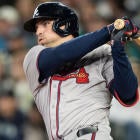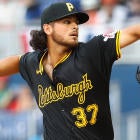"Sleeper" is among the most-searched terms for Fantasy Baseball, so you'd think the meaning would be obvious to all. But the truth is everyone has his own definition.
Here's mine: A player who I can get for less than I think he's worth.
Simple, right? Well, why would I want to confine myself? Make it too narrow and I have to force in a bunch of players who I'm not so invested in drafting. And that's no good for anyone.
Of course, there's also such thing as too broad. "Sleeper" implies some level of anonymity, which again means different things to different people. But while my early drafting has led me to believe I can take Dustin Pedroia much later than he probably deserves, I can't in good conscience call a former MVP and the chairman of Red Sox Nation a sleeper. So he's out.
And that's fine. I have other places to sing the praises of players like him, and I will if you stick here through the rest of draft season. For now, though, you can get to know these players.
At 33, Morales would seem to be the quintessential is-what-he-is player.
Except he's not. His career to this point has had four distinct chapters. First, he was the Cuban defector struggling to adapt to his new environment, then the fulfilled investment pacing a playoff-bound Angels lineup, then the ghost of his former self after missing nearly two years with a gruesome leg injury before finally having this late-career resurgence with the Royals.
Even last year we saw two different versions. The Morales of the first two months hit .193 with six homers and a .591 OPS. The Morales of the last four months hit .296 with 24 and an .888 mark. Particularly for players his age, it's never as simple as taking the numbers from the last however many games and projecting them over a full season. That is, by its nature, a series of corrections and counter corrections, but Morales' BABIP during that stretch was a sustainable .318. The unusually high home run production helped, but it's not like his ISO was out of line with his Angels days.
And now he's entering the most promising chapter of all: Toronto, an organization most known for getting the most out of power hitters, from Jose Bautista and Edwin Encarnacion, who were significantly lower-end than Morales upon arrival, to Josh Donaldson, who was significantly higher-end.
The Blue Jays' home park probably has something to do with it. It consistently ranks among the most hitter-friendly in baseball, and for Morales, its impact might be even more palpable. His fifth organization is his first with a park that favors hitters, and of his 30 home runs last year, 18 came on the road.
If he's having that much success on balls out of play, his in-play average supports him hitting .290. And if he does that, he's back to where he was in his Angels days and a gem of a late-round pick, even if he's confined to your DH spot.
Ray struck out 218 batters last year. It's enough to make you say ...
But of course, you weren't. You were passing him over because of his ERA and WHIP, and I can't say I blame you.
But which is the more revealing number?
It's 2017, but I'll help you out anyway. Ray allowed a .352 BABIP. The next-highest among qualifiers was .339. So there's some of the WHIP inflation right there. Not surprisingly, his FIP (which estimates ERA based on the factors most within a pitcher's control) came in more than a run lower than his actual ERA -- and that was with a not-so-great 3.7 walks per nine innings.
But even the walk rate wasn't an accurate reflection of his abilities. Over his final 20 starts, he issued 3.2 walks per nine, which isn't exemplary but was better than Jake Arrieta, Cole Hamels and Marco Estrada had last year. Also, his rate of strikes to balls, a career high, was better than the MLB average, so it's not like he was wild or anything. It's just that his improvements manifested more in the form of command than control, which is what manager Chip Hale and catcher Welington Castillo (both out of the picture now, for what it's worth) credited for the escalating strikeout rate, with Hale even suggesting Ray was now equipped to win 20 games.
(That's manager code for "he's really good.")
Never were those improvements more apparent than his first eight starts of the second half, when Ray looked like he might disqualify himself for this list with a 3.21 ERA, 1.15 WHIP and 12.5 strikeouts per nine innings. Maybe he tired in September or maybe he fell back into some bad habits, but in either case, he offered a glimpse of what could be with the next stage of his development, which involves keeping the walks down and getting some help from his (likely improved) defense.
So what we're looking at with Ray is a pitcher who already strikes out hitters at the rate Max Scherzer and Noah Syndergaard and is improving in every other regard.
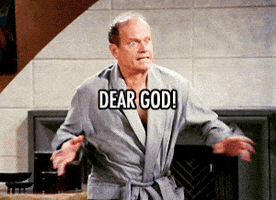
That's right. Come to papa.
So here's a fun exercise: Take Broxton's numbers from his time as a near-everyday player for the Brewers -- that all-too-brief period after they mercifully benched Ramon Flores in late July, right up to the point when Broxton broke his wrist in mid-September -- and project them over 150 games. What do you get?
A .294 batting average, 26 home runs, 52 stolen bases and .937 OPS -- and in only 466 at-bats.
Obviously, it's not that easy. Broxton had an absurd .425 BABIP during that stretch, and striking out one every three at-bats may ultimately be his undoing. But he also walks a lot, has surprising power and can run out of his mind. These abilities were just as evident during his time at Triple-A Colorado Springs, where he hit .287 with eight homers, 18 steals and a .924 OPS in 199 at-bats.
The point is you shouldn't overlook just how productive he was during his time as a major-league starter, because he's so skilled in so many ways that he doesn't need to hit all the right notes to make a significant contribution. And the most reliable of those contributions, stolen bases, just so happens to be the one you'll be in most desperate need of late in Rotisserie drafts. If all breaks right, he could conceivably carry you in the category.
Of course, all breaking right includes the Brewers giving him the chance, which so far they've been reluctant to do, and the closest of their center field prospects, Lewis Brinson is already on the verge of breaking through. But why rush him, right?
In Broxton, they may well have the outfield version of Jonathan Villar, another player whose diverse skill set allowed him to overcome a high strikeout rate for a next-to-nothing cost to his Fantasy owners.
I have this mental hurdle with Kiermaier that tells me because he's an elite defender, he'll never amount to anything offensively.
I mean, that's fairly obvious, right? Sure, he runs fast, but he doesn't know what he's doing on the bases.
Actually, he was 21 for 24 on stolen bases last year, and seeing as he played only 105 games, that projects to about 30 over a full season.
OK. Well, he's too much of a lightweight for today's game, what with no power and all.
Actually, the dozen homers he hit last year project to about 20 over a full season, making him a 20-30 man, hypothetically. And oh yeah, his .164 ISO ranked higher than those of actual 20-homer men Xander Bogaerts, Ian Desmond and Nomar Mazara.
Fine, but the strikeouts. He can't make the most of those tools if he's whiffing every other at-bat.
OK, but what if it's just in 17.9 percent of his plate appearances? That's Joey Votto territory, and he's only a .313 hitter for his career. And what do you know? Kiermaier had just a .278 BABIP last year, about 30 points lower than normal. Some correction there makes him a .270-hitting 20-30 man with ordinary (read: non-prohibitive) strikeout and walk rates. Sounds like Johnny Damon production.
All right, fine! But there's a reason he played only he played only 105 games, right? He's a left-handed hitter. Platoon player! Terrible!
Except he actually hit lefties (.262) better than righties (.241) last year. Played his fair share against them, too. No, the games he missed were mostly because of a fractured hand.
Oh, and he ended the year on one of his best stretches ever, batting .296 with five homers, eight steals and an .874 OPS in September.
Well, what the heck? Kiermaier may have started out as a bad (or let's say suspect) hitter, but under the cloak of night (or injury), he has become a good one with bad luck. I don't know if the draft will last long enough for you to take him in a three-outfielder Head-to-Head league, but in a Rotisserie league, where five outfielders are typical and stolen bases are scarce, you want him late.
Everyone knew Bell was college-bound in 2011, but the Pirates wagered their second-round pick on him anyway and then forked over a record $5 million to convince him to sign. So, yeah ... his upside was apparent from the get-go. What wasn't was his power production, which remains mostly theoretical now five years into his professional career. And that's partly why I say this home run is the most impressive I remember seeing hit last year (non-Rajai Davis division):
You get all that?
Such a big moment. Such an impressive distance. Such an effortless swing from a player who should have been nothing short of terrified, who we've heard may struggle to hit the ball out of the park, and who looks freaking imposing in the batter's box with those broad shoulders and that tight physique.
I'll admit reading so much into a singular swing is unapologetically romantic, but I want a reason to believe in Bell. In his first extended look at major-league pitching, he walked more than he struck out (21 to 19), continuing the exceptional plate discipline that made him a .303 hitter in the minors. These days, you just don't see players, much less rookies, with an approach so advanced. If he adds power, even just the 25-homer variety, we're talking early-round production.
The scouting reports say he should. My eyes says he will. My wallet says it's only a buck. My heart says go for it.
To have faith in Garrett Richards is to have faith in modern medicine.
Yeah, I said it.
At last report, Richards needed Tommy John surgery. You may remember amid the obscenities you were shouting as you dropped him in early May. But news flash: He didn't actually have Tommy John surgery, and yet here he is gearing up for the start of 2017.
What he had was stem cell therapy, a treatment still in its infancy in sports medicine. But even knowing the extent of the damage to his elbow, actual doctors have in fact cleared him to pitch again, and the Angels' enthusiasm has been far from restrained.
"It's a big sigh of relief, as an organization," pitching coach Charles Nagy said after watching Richards pitch four innings, his fastball registering in the mid-90s, during an instructional league start in October, according to The Orange County Register. General manager Billy Eppler, meanwhile, said he was "as excited as I get."
Even Richards, while calling himself Garrett Richards 2.0, spoke reflectively of his recovery and not like a player still in the throes of it.
"I hope this opens doors for other guys," he said. "You don't have to get surgery right out of the gate. If you are fortunate enough to be able to go this route and have the timeline I did, why would you automatically go in and have yourself cut and miss two years of baseball?"
But pitchers still get hurt, of course, and the ones at the greatest risk for it are the ones who've already been hurt. Plus, Richards' innings will surely be limited in his first year back, and the last time he pitched a full season (2015), he wasn't exactly at his best.
But in 64 starts since the beginning of 2014, he has a 3.11 ERA, 1.16 WHIP and 8.2 strikeouts per nine innings. Pitchers so good aren't often available so late.
Have you checked out the catcher rankings yet? Egad.
Going by last year's numbers, only 11 players really amounted to anything Fantasy-wise, and that's including partial seasons from Gary Sanchez and Willson Contreras. And then when you consider that the fallback options are names like Yadier Molina, Stephen Vogt and Matt Wieters -- players on their way out instead of in -- it's hard to get excited about anything the position has to offer.
Then, there's Murphy, a 26-year-old rookie who lacks a top-prospect pedigree and remains under the radar as a result. He's in the same spot Trevor Story was going into last season as an all-or-nothing hitter whose home park is perfectly suited to mask his shortcomings. Pitches don't move as much at Coors Field, giving hitters a better chance of making solid contact, and because the expansive outfield gives batted balls a better chance of dropping, a player can strike out every third at-bat and still post a respectable batting average.
As for power, he homered five times in 44 at-bats down the stretch last year, giving him eight in 79 at-bats between two seasons. Small sample? Sure, but with a long gap in between. And seeing as he hit .404 with 17 home runs in his final 198 at-bats at Triple-A ...
(Let that process for a minute.)
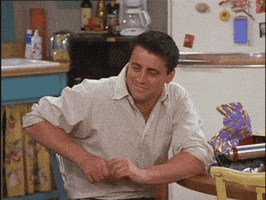
... yeah, I'm thinking he can hit it out anywhere.
The only caveat -- and it's a big one -- is that the Rockies really seem to like Tony Wolters, a 24-year-old who's an inferior hitter but an expert pitch framer. It's the only reason I don't already rank Murphy among my top-12 catchers, but even if he gets only, say, 350 at-bats, it might be enough for him to stand out at this position.
This one isn't especially complicated.
You may have heard stolen bases are scarce. It's no wonder why. Only 14 players reached the 30-steal threshold last year, and three of them -- Rajai Davis, Jarrod Dyson and Travis Jankowski -- you'd only draft if you were desperate for steals.
Peraza contributes more than that, having hit .324 as a rookie, and with a .361 BABIP that, given his foot speed and line-drive rate, isn't so dubious.
You may have also heard the Reds are shopping Zack Cozart, Brandon Phillips and Billy Hamilton. It's no wonder why. They play the three positions Peraza plays, which gives the Reds ample opportunities to work in the 22-year-old even if they don't succeed in trading one of the three.
Shortstop is the position we care about most, and Peraza is already eligible there, offering transcendent speed at a point in the draft where you'd normally have to block an outfield spot to get it. And before you go thinking he's just a Rotisserie darling, note that in his 56 starts last year, he averaged nearly as many Head-to-Head points (3.07) as Francisco Lindor (3.11).
I'm not suggesting he's as good as Lindor. He has to be an elite contributor in the two areas where he excels, stolen bases and batting average, to measure up, which gives him a higher margin for error. But how often a player runs and how often he makes contact don't always translate to the majors, which is why so many prospects of Peraza's profile have faded into oblivion. He has already shown he can do it. Now, it's up to the Reds to get him in the lineup.
Can't say they aren't trying.
Speaking of trying to clear a spot for someone, Mariners GM Jerry DiPoto made a couple of trades in late January that didn't exactly send shockwaves through the Fantasy Baseball world, shipping Seth Smith to the Orioles and then acquiring Jarrod Dyson from the Royals. But with that two-step outfield exchange, he made his intentions perfectly clear:
Defense first.
So where does Haniger come in? Well, he's really good at it, at least by DiPoto's own assessment.
"He's athletic, plays all three spots, throws very well and very accurately," Dipoto said in early December. "He's an excellent defender."
It's not the only positive thing he has had to say about Haniger since acquiring the 26-year-old as a "throw-in" in the Jean Segura deal.
"There are many situations where at 25, a guy has performed his way onto the major-league scene, and because he wasn't adored by prospect ratings systems, he kind of flies under the radar," DiPoto said just a few days after the trade. "But a lot of times, they'll turn out to be really good players. We had a guy like that in Anaheim, Kole Calhoun, who turned out to be a heckuva player. I think Mitch Haniger has a lot of that ability as well."
And, more to the point ...
"I feel like Mitch Haniger is an every day outfielder," he said.
Well, guess what? DiPoto is the one who can make it happen, and after the Smith-for-Dyson exchange, he confirmed it: Haniger is the Mariners' intended starter in right.
So why should you care?
Because judging from the numbers and the story behind them, DiPoto's instincts are spot on. Haniger hit .321 with 25 homers and a .999 OPS between two minor-league stops last year, showing plus plate discipline in the process. It's a skill set that made him the 38th overall pick in the 2012 draft, but after he stalled in the lower levels, he faded from the prospect discussion.
His transformation came after a conscious decision to remake his swing, modeling it after A.J. Pollock (a good guy to emulate), and the results speak for themselves. Haniger hasn't quite entered the mixed-league discussion yet, but a big spring will change that.
He hit only .239 last year. Everybody, Panik!
You think I gave a take just then, but all I did was present a timely fact and introduce the man, sort of like Jimmy Fallon would do. And with the kind of player Panik is poised to become, he'll be making the talk show rounds when the Giants win their next world championship nobody sees coming.
You may recall I named Panik a sleeper last year, when he had just hit .312. I believe he is fundamentally the same player he was then -- nay, even better -- so after a year in which he lowered perception further, it goes without saying he'd be a sleeper for me again.

Panik had more walks than strikeouts last year. He was already good at both, and he became even better. His strikeout rate of 8.9 percent led all of baseball, in fact. Jose Altuve and Daniel Murphy -- who hit .338 and .347, respectively -- were third and fourth.
Making that much contact, the only way he could have such a low batting average is by having an absurdly low BABIP. Sure enough, his .245 mark was second-worst in all of baseball, and the only five other hitters with a BABIP less than .260 were extreme fly-ball hitters, which sort of comes with the territory. Panik's .330 BABIP in 2015 is more befitting a player of his abilities.
So what? He'll hit for average, then.
That's not exactly a small deal in Fantasy these days, with strikeout rates continuing to swell and trustworthy sources becoming fewer and farther between. In the late rounds, where you can nab Panik, they're nearly impossible to find and typically come at the expense of everything else. Panik, though, could give you about a dozen homers, at least if you project out his numbers from, the past two years. And that stellar strikeout-to-walk ratio will make him a poor man's Dustin Pedroia in Head-to-Head points leagues.
He may go undrafted in that format, given its smaller roster sizes and the fact he's on the wrong side of the divide at a position of haves and have-nots. But he's right at the edge and the most likely player to bridge it before season's end.
So maybe the White Sox trade David Robertson and escalate Jones' value to the point he no longer qualifies as a sleeper. It's kind of the nature of the closer role, prompting sudden and sweeping changes in value. But my point in mentioning him here isn't just "hey, he's next in line for a team tearing everything down" but also "hey, he'll be really good in the meantime."
He's not quite Andrew Miller or Dellin Betances, the only two setup men who will for sure be drafted in every Rotisserie league, but he's on the next rung of the ace reliever ladder, ranking 20th among relievers (minimum 50 innings) in ERA, 13th in strikeout-to-walk ratio and, most impressively, sixth in WHIP.
And oh yeah, he was in line to become the White Sox's closer in 2014, before needing Tommy John surgery. By the time he returned, Robertson was under contract and Jones was forced to set up. Time to right that wrong.
It's not a stretch to say that, even with a modest save total closing for a rebuilding team, Jones could be a top-10 reliever in Fantasy -- maybe even higher if Craig Kimbrel and Wade Davis aren't right. The ratios are that good.
And since they are that good, you won't mind having them in your lineup while you await the transition. He won't be a game-changer in the setup role, but in leagues where saves are scarce, that's not a bidding war you'll want to have later.
OK, so I know citing just a partial season of data is a dangerous game, but in the case of Finnegan, we have a clear and demonstrable reason for the change -- one that leaves as little room to the imagine as I can remember in my time picking sleepers for CBS Sports.
The period in question is a seven-start stretch from Aug. 20 to Sept. 25 in which he compiled a 1.93 ERA, 1.15 WHIP and 11.33 strikeouts per nine innings. Notice anything about his pitch usage during that time?
| | ||||
| Game | Fastball | Sinker | Slider | Changeup |
| CIN@CHC (7/5/16) | 26.37 | 45.05 | 23.08 | 5.49 |
| ATL@CIN (7/18/16) | 21.88 | 44.79 | 27.08 | 6.25 |
| ARI@CIN (7/24/16) | 34.48 | 42.53 | 19.54 | 3.45 |
| CIN@SD (7/29/16) | 13.33 | 56.67 | 17.78 | 12.22 |
| STL@CIN (8/4/16) | 25.32 | 39.24 | 29.11 | 6.33 |
| CIN@STL (8/9/16) | 18.09 | 39.36 | 30.85 | 11.70 |
| MIA@CIN (8/15/16) | 26.80 | 36.08 | 26.80 | 10.31 |
| LAD@CIN (8/20/16) | 26.04 | 33.33 | 28.13 | 12.50 |
| CIN@ARI (8/26/16) | 21.65 | 36.08 | 18.56 | 23.71 |
| CIN@LAA (8/31/16) | 36.90 | 15.48 | 29.76 | 17.86 |
| NYM@CIN (9/6/16) | 17.31 | 32.69 | 29.81 | 20.19 |
| CIN@PIT (9/11/16) | 22.11 | 35.79 | 17.89 | 24.21 |
| PIT@CIN (9/17/16) | 40.96 | 26.51 | 12.05 | 20.48 |
| CIN@MIL (9/25/16) | 33.33 | 22.22 | 14.81 | 29.63 |
(data from BrooksBaseball.net)
Hey, where did that changeup come from? That's the third pitch Finnegan was lacking (seeing as a sinker is really just an alternate fastball). So often the development of one is the biggest hurdle for aspiring starters, and you may remember some evaluators pegged Finnegan for the bullpen from the get-go.
And the fact it's a changeup is especially notable because that's the pitch with the best chance of neutralizing opposite-handed hitters. Now, he just needs to master it, which I'm sure if we look at the whiff percentages, we'll discover he's not at all ... oh.
| | ||||
| Game | Fastball | Sinker | Slider | Changeup |
| CIN@CHC (7/5/16) | 4.17 | 7.32 | 14.29 | 0.00 |
| ATL@CIN (7/18/16) | 4.76 | 6.98 | 15.38 | 0.00 |
| ARI@CIN (7/24/16) | 13.33 | 10.81 | 17.65 | 0.00 |
| CIN@SD (7/29/16) | 0.00 | 11.76 | 0.00 | 0.00 |
| STL@CIN (8/4/16) | 10.00 | 12.90 | 8.70 | 0.00 |
| CIN@STL (8/9/16) | 0.00 | 5.41 | 20.69 | 9.09 |
| MIA@CIN (8/15/16) | 7.69 | 2.86 | 11.54 | 20.00 |
| LAD@CIN (8/20/16) | 20.00 | 6.25 | 18.52 | 16.67 |
| CIN@ARI (8/26/16) | 4.76 | 5.71 | 11.11 | 52.17 |
| CIN@LAA (8/31/16) | 6.45 | 7.69 | 28.00 | 40.00 |
| NYM@CIN (9/6/16) | 22.22 | 5.88 | 9.68 | 14.29 |
| CIN@PIT (9/11/16) | 9.52 | 8.82 | 17.65 | 21.74 |
| PIT@CIN (9/17/16) | 14.71 | 9.09 | 0.00 | 5.88 |
| CIN@MIL (9/25/16) | 5.56 | 8.33 | 12.50 | 18.75 |

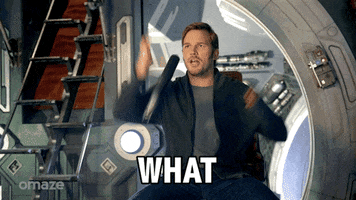
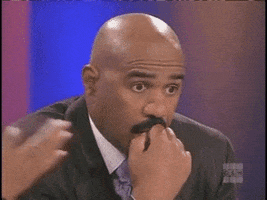
Well, how about that? It was his very best pitch.
Small sample, yes, but if you wait around for a big one, by that point the value is gone. Finnegan had struggled to find a changeup grip over his career, picked up a new one from Dan Straily, and thus may have turned the corner as a pitcher who had long impressed with his stuff.
He's not a finished product yet, needing to shore up his control to become a reliable Fantasy option (those 12 walks during a three-start stretch in September skewed his WHIP during the brilliant seven-start stretch), but you don't see people questioning whether he can make it as a starter anymore. Compared to more celebrated pitching talents like Robert Stephenson and Cody Reed, he was the one of the Reds young hurlers who actually offered some hope for the future.







